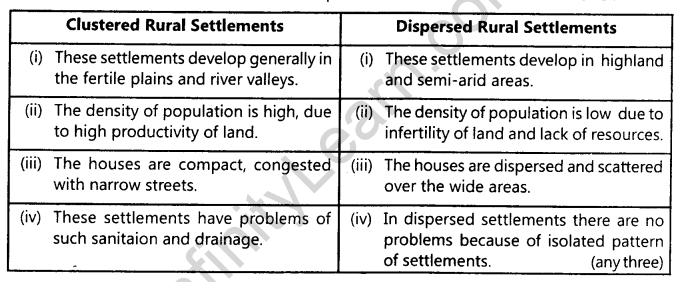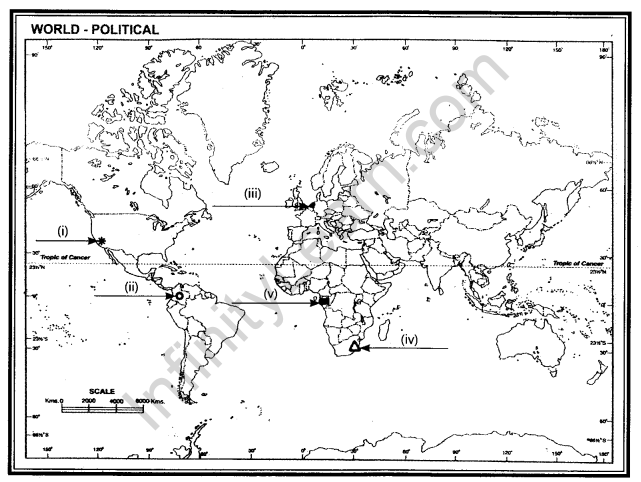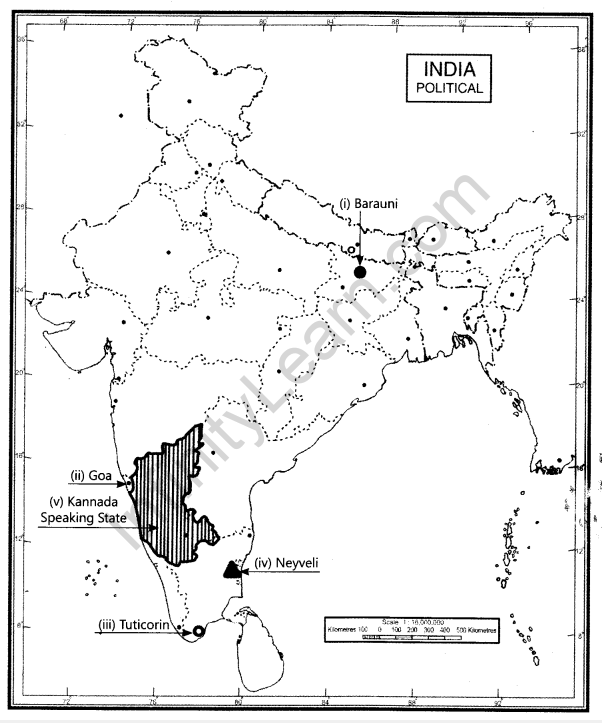CBSE Class 12 Geography Sample Paper With Solutions Set 5
[Time Allowed : 3 hrs.] [Max. Marks : 70]
Questions 1-7 (1 Mark), 8-13 (3 Marks), 14-20 (5 Marks), 21 and 22 (Map Question-5 Marks each)
Q.1.Name the areas of low density.
Ans. The areas of low density include dry lands, cold lands, major mountain ranges where climatic conditions are adverse and wet tropical with heavy precipitation and high temperature.
Q.2. Name the valley region of Germany, which produces more than 80 % steel production.
Ans. The Ruhr Valley region of Germany produces more than country’s 80% steel production.
Q.3. Name the largest metropolitan city of Uttar Pradesh. Write its population according to the census 2011?
Ans. Allahabad is the largest metropolitan city of Uttar Pradesh. Its population according to the census 2011 was 2.90 million.
Q.4. In which Five year Plan of India was Hill Development Programme initiated?
Ans. The Hill Area Development Programme was initiated in the fifth Five Year Plan.
Q.5. Name the iron and steel plant located in Chhatisgarh.
Ans. The Bhilai Iron and Steel Plant is located in Chhatisgarh.
Q.6. What is the rank of Indian Railway System in the world?
Ans. India is ranked fourth in the Railway System of the world.
Q.7. What is meant by urban smog?
Ans. Smoky fog caused by pollutants over cities is called as urban smog.
Q.8. Which approach was followed by F. Ratzel and E.C Semple in the study of human geography? State two characteristics of this approach.
Ans. F. Ratzel and Ms E.C. Semple are staunch supporters of the ‘Environmental Determinism’. The two characteristics of environmental determinism are :
•All activities of the human beings are determined by the environment in which he lives.
•Environmental determinism considers man as an active agent and nature as a passive agent.
German geographers e.g. Hippocrates, Aristotle, Herodotus, Strabo, Immanuel Kant, Humboldt, Ritter Ratzel, E.C. Semple and Huntington are the main supporters.
Q.9. Explain the world’s population on the basis of density of population.
Ans. Population density is an important measure to analyse population distribution. On that basis, the world’s population is divided into three groups i.e. high, medium and low.
•Areas of low density of population: The hot and cold deserts of the world, the equatorial regions with high rainfall and dense evergreen forests are the sparsely populated regions of the world. These areas have population density with less than 1 person per sq. kilometre.
•Areas of moderate density of population: The western parts of Asia, Europe (Latvia, Norway, Sweden, Denmark, Estonia and Lithuania), central and western parts of USA and Australia, are having 11 to 50 persons per sq. kilometre.
•Areas of high density of population: Eastern and south-eastern and southern Asia, the north-western European countries and the north-eastern lake regions of USA are densely populated with more than 200 persons per sq. kilometre.
Q.10.Cotton textile industry has three sub-sectors, i.e handloom, powerloom and mill sectors: Handloom sector is labour-intensive and provides employment to semi-skilled workers. It requires small capital investment. Why did Mahatma Gandhi propagate Khadi as part of the independence movement? This sector involves spinning, weaving and finishing of the fabrics. The powerloom sector introduces machines and becomes less labour intensive and the volume of production increases. Cotton textile mill sector is highly capital intensive and produces fine clothes in bulk. Read the above paragraph and . analyse the following:
(i)Name the three sub-sector of the cotton textile industry.
(ii)Who propagated “Khadi” as a part of the independence movement, and what kind of values did it show.
Ans. (i) The three sub sectors of the cotton textile industry are:
(a) Handloom Sector (b) Powerloom Sector (c) Mill sector
(ii)’Mahatma Gandhi’ propagated “Khadi” as a part of the independence movement. The values reflected through it were ‘nationalism and boycott of foreign goods’. It influenced the development of cottage industries which provided rural employment.
Q.11.Distinguish between clustered and dispersed rural settlements of India by stating three points of distinction of each.
Ans. Differences between clustered rural and dispersed rural settlements are as follows :

Q.12.The Petlawad block of Jhabua is located in the northernmost part of the district and represents an interesting and successful case of Government-NGO partnership and community participation in managing watershed programmes. The Bhils in Petlawad block, for example (Sat Rundi hamlet of Karravat village), through their own effort, have revitalized large parts of common property. They also have planted fodder grass on the pasture land and adopted social-fencing of these lands for the least for two years. Even after that, they say, there would be no open grazing on these lands, but stall feeding of cattle, and they are thus confident that the pastures they have developed would sustain their cattle in future.
Read the above paragraph and analyse the following:
(i)Where is the Petlawad block located?
(ii)What kind of value they have shown.
Ans. (i) The Petlawad block of Jhabua is located in the northernmost part of the district of Madhya Pradesh.
(ii) The scheduled tribe Bhils in Petlawad block, through their cooperation towards sensitising the environment, they revitalized the large parts of common property resources. (CPRs) It shows the value of collective response of community towards environment.
Q.13. The urban air quality in India is deteriorating? Explain any four factors responsible for it.
Ans. The following are reasons for the deteriorating quality of air in urban areas are :
•Industries emit several poisonous gases, ash and dust into the air.
•Increasing vehicles on the roads release carbon monoxide and lead oxide into the air.
•Chlorofluorocarbon is also emitted in the atmosphere.
•Deforestation is causing increased concentration of carbon dioxide and other gases in the atmosphere.
Q.14. How has modern communication system converted the whole world into global village? Explain with four suitable examples.
Ans. Modern means of communication has made the world a small place to live or they have converted the world into a global village.
•Telephones are the most important means which have reduced the distances. STD and ISD facilities available round the clock at every yard provide constant contact with people who may be in any part of the world.
•Satellite television has revolutionised the communication system. Important event be it political, entertainment or sports, one can enjoy sitting at home. We don’t feel the distance and TV is the cheapest means which has brought the entire world in our time.
•Computers and internet has also brought the world just click of mouse away. E-mail facilities available on the computer enable us to talk or get informed about our near and dear ones. These days all the business work is done on the E-mails, as it is the fastest way.
•The modern communication connected the entire world. Telephone, TV, e-mails and internet have brought the entire world in our homes. So we can say that means of communication have made the entire world a global village.
Q.15. What are highways? Explain their significance with examples from different continents.
Ans. Highways. Highways are metalled roads which connect distant places. These roads are made in such a way that vehicles can ply in an unobstructed manner.
The characteristics of modern highway of the world are :
•Highways are wide roads, these roads are more than 80 metres wide.
•Highways have several traffic lanes.
•Bridges, flyovers and embankments are common features of highways.
•Highways allow uninterrupted flow of traffic at high speed.
In Europe, every city and port town is linked through highways facilitating fast movement of vehicles carrying goods and people on these roads.
In North America highways link cities located in eastern and western coasts as well as towns in Canada and Mexico. Thus, these roads have reduced the regional disparity in terms of development. ,
National Highway No. 7 in India is the longest highway in the country. It links Varanasi with Kanyakumari.
Q.16. What are the ‘squatter settlement’ and slums ? Describe three main characteristics of squatter settlements.
Ans. Slums: A run down settlement or a part of a settlement, usually near or urban area and characterised by dilapidated buildings, the poverty of its inhabitants, squator, the presence of refuse, and over population.
Squatter Settlements: Settlement type one who occupies without legal entitlement.
•They have also similar condition but on account of lack of legal entitlement.
•The migrants may have family elsewhere in a village.
•There is also lack of basic amenities though informally arranged.
•The squatters may arrange for their own inferior and temporary conveniences.
Q.17. Describe the main features of three broad groups of India’s population, based on age.State four major problems associated with these age groups.
Ans. Age structure is an important element in the study of the population structure of a country. Age structure of population gives an indication of the population in different age groups. On the basis of age, three broad groups of population are the following :
•Young age group : 0-14 years of age.
•Adult age group : 15-59 years of age
•Old age group : People of 60 years and above.
The four major problems associated with these age groups are as follows :
•As per Census 2001,35.6 per cent of the India’s total population is young and economically unproductive.
•The high capital expenditure is on their maintenance, food, clothes, education etc, which influence the rate of saving.
•The old age group is only 6.3 per cent as per Census 2001 high expenditure of medical facilities.
•The dependency ratio (41.9 per cent) also affected the low growth rate of economic and social development.
Q.18. Discuss five major points of the Integrated Tribal Development Project implemented in Bharmaur region.
Ans. Following steps are taken for the attainment of tribal sub-plan strategy :
(i) Development of economy by improvement of agriculture, comprehensive land reforms, soil conservation, afforestation, irrigation facilities, etc.
(ii)Employment generation through allied activities like horticulture, animal husbandry and cottage industry.
(iii) Improvement in the basic infrastructure of health, education, training, communication,
marketing, credit and electricity supply.
(iv)Attending the problems of special groups like thedisplaced persons, migrants, bonded labourers, forest villagers, shifting cultivators and the tribal groups like Gaddi tribal group of Chamba district of Himachal Pradesh.
(v) Review of forest and excise policies and improvement as well as conservation of environment.
Q.19. Which are the two main ferrous minerals found in India? Describe four characteristics of each.
Ans. Iron and manganese are the two ferrous minerals found in India :
(i)Four characteristics of iron ore :
•Iron ore is the basic mineral and backbone of Indian industry.
•Haematite and magnatite are the high grade of iron ore, whereas limorite and sederite ores are also found.
•Chhattisgarh, Jharkhand, Goa, Karnataka, Orissa and Andhra-Pradesh are the principal iron ore producing states.
•India export half of its iron ore to Japan and also import steel.
(ii)Four characteristics of Manganese:
• Manganese mainly used as an alloy in the manufacturing of non-abrasive and non-corrosive steel.
• India is the second largest producer of manganese after Zambia.
• It is also used in the dyes, paints, pesticides and chemical industries.
• Orissa, Madhya Pradesh, Karnataka, Goa and Maharashtra are the principal manganese producing states.
Q.20. Describe the main characteristics of our international trade after independence.
Ans. Following are the main characteristics of our international trade after independence :
• It has only increased in volume and value but the changes in its direction have also taken place. We are no longer tied to the one side trade relations with Great Britain and other commonwealth countries as was the position before the attainment of independence.
•We now supply both the raw materials and manufactured goods to foreign countries.
•Our main exports are tea, jute, cotton, iron-ore, coffee and engineering goods etc. We import machinery, mineral oil, long staple, cotton, chemicals, copper, transport equipment paper, newsprint, fertilisers etc.
•We are having increasing trade relations with USA, Canada, Australia, Japan, Russia, Europe and oil producing countries rather than with Great Britain.
•Our exports now enable us to import specialised machinery, oil, certain ores etc., which are in short supply in our country.
Q.21. On the given outline map of the World, following five features are shown. Identify these features and write their correct names on the lines marked near each feature.
(i)Mega City
(ii)A major Airport
(iii)Country famous for horticulture
(iv)A major seaport
(v)The country having the lowest population in Africa.

Ans. (i) Los Angeles (ii) Bogota (iii) Netherlands (iv) Durban (v) Gabon
Q.22. On the given outline map of India, locate and label the following with appropriate symbols:
(i)The oil refinery located in Bihar.
(ii)The state having the highest % of urban population.
(iii)The southernmost sea port of India
(iv)The lignite coal reserve of Tamil Nadu
(v)Kannada speaking state.
Ans.





